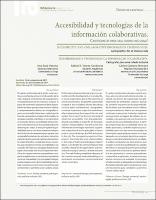Por favor, use este identificador para citar o enlazar este ítem:
https://repositorio.usj.es/handle/123456789/299
Registro completo de metadatos
| Campo DC | Valor | Lengua/Idioma |
|---|---|---|
| dc.contributor.author | Ruiz-Varona, Ana | - |
| dc.contributor.author | Temes-Cordovez, Rafael R. | - |
| dc.contributor.author | Cámara-Menoyo, Carlos | - |
| dc.date.accessioned | 2020-01-16T11:19:45Z | - |
| dc.date.available | 2020-01-16T11:19:45Z | - |
| dc.date.issued | 2018 | - |
| dc.identifier.citation | Bitácora Urbano Territorial, Volumen 28, Número 1, p. 171-178, 2018. ISSN electrónico 2027-145X. ISSN impreso 0124-7913. | es_ES |
| dc.identifier.issn | 2027-145X | es_ES |
| dc.identifier.uri | https://repositorio.usj.es/handle/123456789/299 | - |
| dc.description.abstract | Performative character of social action is an active force in the development of everyday life, in social organization and in the planning of urban environments. Despite the exponential increase in the availability of data describing our daily habits and behaviors, cartographies continue to present subjective limitations when representing the image of the city and society. This is clear if we focus on the study of urban non-accessibility. From the understanding of accessibility as a right for all, the paper explores the possibilities that the use of new information technologies represents to generate a map based on the principles of space justice, universal design and full autonomy in the city. The comparative analysis of two projects that study the level of accessibility in the cities of Valencia and Zaragoza (Spain) allows us to identify the common features that could be shared by the applications and mechanisms trying to construct a more inclusive city. The main findings reveal the adequacy of the crowdsourcing led work methodology as a mechanism to counteract current social and urban asymmetry. | es_ES |
| dc.format.extent | 8 p. | es_ES |
| dc.format.mimetype | application/pdf | es_ES |
| dc.language.iso | spa | es_ES |
| dc.publisher | UNIV NACL COLOMBIA, CIUDAD UNIVERSITARIA CARRERA 30 NO 45-03, BOGOTA BC, 00000, COLOMBIA | es_ES |
| dc.relation | Este trabajo contó con una ayuda de investigación de la Universidad de Zaragoza, Fundación Bancaria Ibercaja y Fundación CAI CH13/17. | es_ES |
| dc.relation.requires | Adobe PDF | es_ES |
| dc.rights | Attribution-NonCommercial-NoDerivatives 4.0 Internacional | * |
| dc.rights | Attribution-NonCommercial-NoDerivatives 4.0 Internacional | * |
| dc.rights.uri | http://creativecommons.org/licenses/by-nc-nd/4.0/ | * |
| dc.rights.uri | http://creativecommons.org/licenses/by-nc-nd/4.0/ | * |
| dc.subject | Universal design | es_ES |
| dc.subject | Participation | es_ES |
| dc.subject | Inclusive policy | es_ES |
| dc.subject | GIS | es_ES |
| dc.title | Accesibilidad y tecnologías de información colaborativas. Cartografías para una ciudad inclusiva | es_ES |
| dc.title.alternative | Accessibility and collaborative information technologies. Cartographies for an inclusive city = Acessibilidade e tecnologias da informação colaborativa. Cartografas para uma cidade inclusiva | es_ES |
| dc.type | info:eu-repo/semantics/article | es_ES |
| dc.subject.unesco | Diseño | es_ES |
| dc.subject.unesco | Política social | es_ES |
| dc.relation.publisherversion | https://revistas.unal.edu.co/index.php/bitacora/article/view/68316/pdf | es_ES |
| dc.identifier.doi | https://doi.org/10.15446/bitacora.v28n1.68316 | es_ES |
| dc.rights.accessrights | info:eu-repo/semantics/openAccess | es_ES |
| Aparece en las colecciones: | Artículos de revistas | |
Ficheros en este ítem:
| Fichero | Descripción | Tamaño | Formato | |
|---|---|---|---|---|
| 68316-369173-2-PB.pdf | 483,42 kB | Adobe PDF |  Visualizar/Abrir |
Este ítem está sujeto a una licencia Creative Commons Licencia Creative Commons

